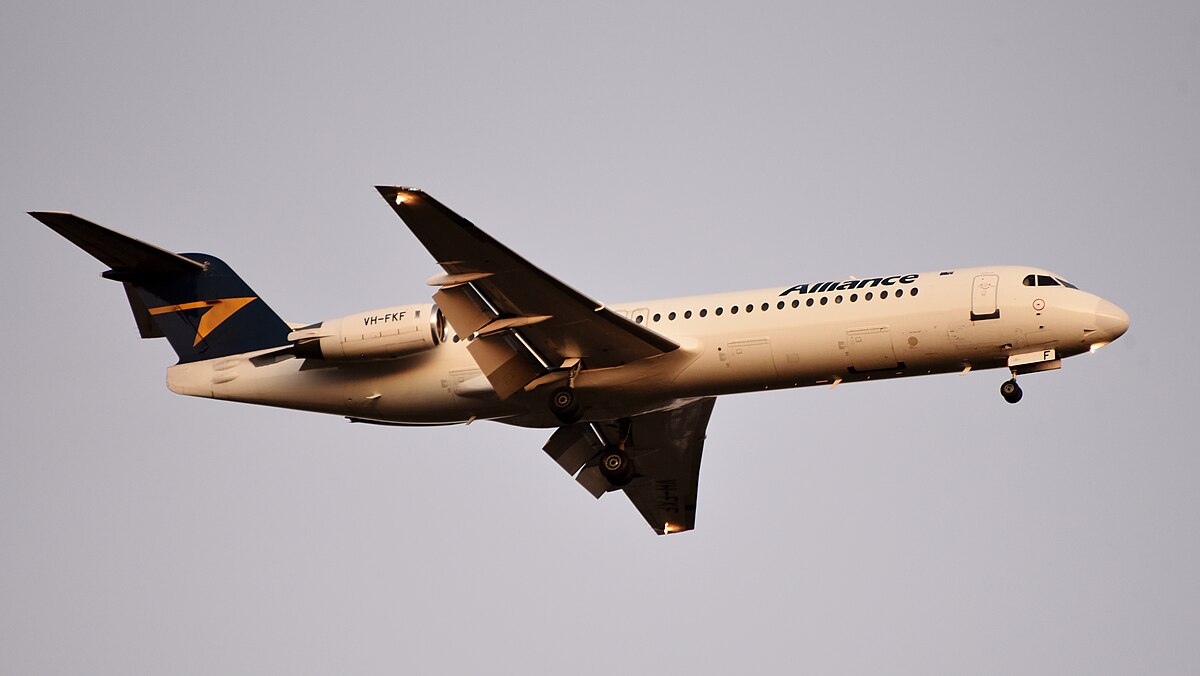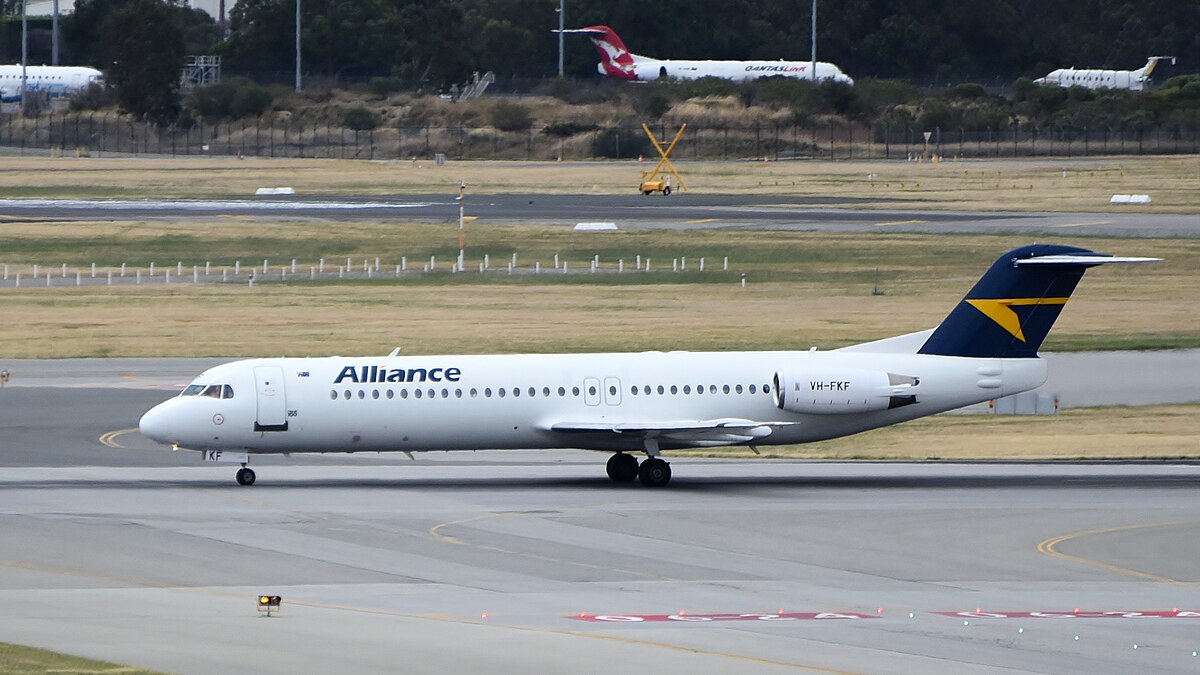Alliance F100 at Perth on Apr 29th 2025, continued unstable approach
Last Update: August 12, 2025 / 06:40:55 GMT/Zulu time
Incident Facts
Date of incident
Apr 29, 2025
Classification
Report
Airline
Alliance Air
Flight number
QQ-3811
Departure
West Musgrave Mine, Australia
Destination
Perth, Australia
Aircraft Registration
VH-FKF
Aircraft Type
Fokker 100
ICAO Type Designator
F100
Australia's ATSB released their final report concluding the probable causes of the incident were:
Contributing factors
- The pilot flying incorrectly assessed that the applicable stabilisation height was 500 ft. As a result, they did not manage the aircraft's energy state to ensure the stabilised approach speed requirement was met by 1,000 ft.
- The pilot monitoring did not announce that the approach was unstable when the speed-related stabilised approach criteria was not met at 1,000 ft. This may have been influenced by workload, the required check being completed slightly late, and an assessment that the airspeed was reducing.
Other factors that increased risk
- Passing the transition level, the captain inadvertently omitted to change the altimeter setting from standard pressure to QNH, resulting in the left altimeter indicating 300 ft lower than the right altimeter. Neither flight crewmember detected the incorrect setting during 2 subsequent checks prior to landing.
The captain was pilot flying, the first officer pilot monitoring.
The ATSB analysed:
The flight crew reported performing the transition checks, which required each flight crewmember setting and then crosschecking that all 3 altimeters were set to the correct pressure subscale. However, neither flight crewmember identified that the captain’s primary flight display (PFD) had not been switched from standard (STD) to barometric pressure (QNH). This was again missed at the required 5,000 ft check, which coincided with air traffic control (ATC) advising of a change in the QNH.
The flight crew also did not identify the error when they later crosschecked that the radio altitudes matched on both PFDs, when passing about 2,500 ft. It could not be determined why this was missed, but it resulted in the captain’s PFD indicating about 300 ft lower than the aircraft’s actual height.
Having the altimeter set correctly is important to ensure the aircraft is operating at the same height basis as other aircraft in the same airspace, and to ensure adequate separation from terrain. In this case, indicating 300 ft lower than actual did not increase the risk of a collision with terrain. Additionally, had the captain, as pilot flying, based the approach profile on the indicating lower altitude, it should have resulted in the aircraft being stabilised 300 ft higher than the stabilisation height. However, by that stage, the flight crew were referencing radio altitude rather than barometric altitude.
The captain reported identifying the discrepancy between the altimeter and the radio altitude at about 1,500 ft, during the turn onto final. Their focus on the discrepancy may have contributed to the delay in achieving the required stabilised speed. However, having assessed the required stabilisation height as 500 ft, the captain was unconcerned (although aware) that the airspeed was fast at 1,000 ft. The airspeed reduced below the stabilisation criterion by 800 ft.
The first officer’s assessment that the 1,000 ft stabilised height applied, and all requirements were met, was consistent with Alliance Airlines’ assessment that the vertical speed deviations were transient and acceptable within the stabilisation criteria.
However, at 1,000 ft, the airspeed was 26 kt above the approach speed, with only a 10 kt exceedance permitted. The pilot monitoring did not call ‘unstable’ as required by the stabilised approach policy. This may have been influenced by the pilot monitoring experiencing the turn onto final as a ‘busy corner’, the required checks being completed slightly below 1,000 ft and an assessment that the airspeed was reducing.
The ATC speed instructions resulted in the aircraft being significantly faster than the published speeds during the standard instrument arrival (STAR).
Additionally, the captain reported some pressure to keep the speed up during the approach. However, according to the Airservices Australia Aeronautical Information Publication (AIP), an ATC-issued speed instruction only applied to the point where the flight crew would reduce the speed on the normal profile for the approach. Furthermore, if flight crew assessed a speed control instruction was unacceptable, they were to request an alternative.
The aircraft’s average descent rate was less than 2,000 fpm between about 14,000 ft to 5,000 ft, during which 270 kt airspeed was maintained. As Alliance permitted up to 3,000 fpm above 3,000 ft, there was opportunity to descend faster earlier in the approach, which would have facilitated more effective speed reduction later in the approach. The airspeed was below the 200 kt landing gear extension speed for about 1 minute before the landing gear fully extended during the turn onto final. As the airspeed was only above the required stabilised approach speed at 1,000 ft for 9 seconds, extending the landing gear, flap, and/or speed brake slightly earlier, would likely have ensured the stabilised criteria could be met.
Incident Facts
Date of incident
Apr 29, 2025
Classification
Report
Airline
Alliance Air
Flight number
QQ-3811
Departure
West Musgrave Mine, Australia
Destination
Perth, Australia
Aircraft Registration
VH-FKF
Aircraft Type
Fokker 100
ICAO Type Designator
F100
This article is published under license from Avherald.com. © of text by Avherald.com.
Article source
You can read 2 more free articles without a subscription.
Subscribe now and continue reading without any limits!
Read unlimited articles and receive our daily update briefing. Gain better insights into what is happening in commercial aviation safety.
Send tip
Support AeroInside by sending a small tip amount.
Related articles
Alliance E190 at Adelaide on Nov 12th 2025, smoke in cockpit
An Alliance Airlines Embraer ERJ-190 on behalf of Qantas, registration VH-UZI performing flight QF-1972 from Adelaide,SA to Canberra,AC (Australia),…
Alliance E190 at The Granites on Mar 8th 2025, landed with flaps 5 instead of full flaps
An Alliance Airlines Embraer ERJ-190, registration VH-A2V performing flight QQ-4801 from Alice Springs,NT to The Granites,NT (Australia) with an…
Alliance E190 at Olympic Dam on Feb 4th 2025, landed with flaps 5 instead of full flaps
An Alliance Airlines Embraer ERJ-190, registration VH-A2T performing flight QQ-3120 from Adelaide,SA to Olympic Dam,SA (Australia) with 90 passengers…
Alliance E190 at Darwin on Feb 12th 2025, unstable approach continued
An Alliance Airlines Embraer ERJ-190 on behalf of Qantas, registration VH-UYO performing flight QF-1888 from Cairns,QL to Darwin,NT (Australia) with…
Alliance AT72 at Bhubaneswar on Oct 8th 2024, "mowed" approach lights, touch down before threshold, tail strike
An Alliance Air Avions de Transport Regional ATR-72-212A, registration VT-RKF performing flight 9I-746 from Rourkela to Bhubaneswar (India) with 43…
Newest articles
Airjet Angola E145 at Kolwezi on Nov 17th 2025, touched down before runway, aircraft in flames
An Airjet Angola Embraer ERJ-145, registration D2-AJB performing flight MBC-100 from Lubumbashi to Kolwezi (DR Congo) with 26 passengers and 3 crew,…
SAS A20N at Oslo on Oct 14th 2025, passenger batteries caught fire during boarding
A SAS Scandinavian Airlines Airbus A320-200N, registration SE-RUR performing flight SK-295 from Oslo to Bergen (Norway), was boarding, about 50…
Subscribe today
Are you researching aviation incidents? Get access to AeroInside Insights, unlimited read access and receive the daily newsletter.
Pick your plan and subscribePartner

ELITE Simulation Solutions is a leading global provider of Flight Simulation Training Devices, IFR training software as well as flight controls and related services. Find out more.
SafetyScan Pro provides streamlined access to thousands of aviation accident reports. Tailored for your safety management efforts. Book your demo today
AeroInside Blog
Popular aircraft
Airbus A320Boeing 737-800
Boeing 737-800 MAX
Popular airlines
American AirlinesUnited
Delta
Air Canada
Lufthansa
British Airways



